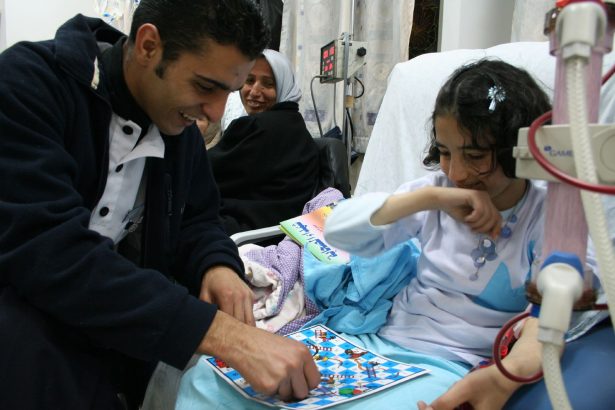An evidence-based analysis of the nature and impact of Israeli public health policies practices in the West Bank and Gaza.
The incendiary claim that Israel has deliberately damaged the health of the Palestinians of the West Bank and Gaza Strip is not evidence-based, argues Dr. David Stone. In fact, the opposite is true: the health of the Palestinians has improved steadily since 1967. Stone maps a cluster of changes – in demography, crude death rates, life expectancy, infant mortality, as well as maternal, perinatal, under-five mortality, immunisation coverage, nutrition and infant growth patterns, primary and secondary health care, and the Israeli influence on ‘the causes of the causes’ of ill health (housing, water, education, employment) – to show that Israeli policies have brought about measurable improvements in Palestinian health and welfare. This was achieved, in the face of formidable obstacles, by a variety of means including an outstanding child immunization programme, the launching of need-responsive innovations in primary care (crucially including maternal and child health services), a large hospital development programme, collaborative modes of working with Palestinian professionals, UNRWA and NGOs, and – arguably even more important – providing high quality training for doctors, nurses and other health providers in Israeli institutions thereby bringing modern standards to anaesthesia, renal dialysis, cardiac surgery and many other critically important fields.
Click to read Dr Stone’s paper in full: Has Israel damaged Palestinian health?



































https://www.youtube.com/watch?v=CqdpK8HmTG4
Israeli official: Hamas lets their people have treatment in Israel, but not regular Gazans
COGAT responds to revelation that Hamas leader’s daughter was treated in Tel Aviv; hospital: we don’t care who the patients are.
Roi Kais
Published: 10.21.14, 16:18
Palestinian leadership makes these off-the-wall claims, confident that they have an audience willing to swallow any outrageous allegation aimed at Jews or Isreal, without question or hesitation.
Their appeal is not to intellect or reason, but to the ugly virus of unreason that resides deep within us all.
For now, they are concert masters to an orchestra of hate…and Europeans are again the enthusiastic choirboys.
Isn’t this just a tired re-run of a movie we have seen before?
Dear Prof. Stone,
I read your article with interest. I was going through the references and couldn’t find the statistics from Tables 3 and 6 which are apparently sourced from the UNICEF State of the World’s Children 2012 report. In particular the data cells in the UNICEF table for the Occupied Palestinian Territories pertaining to under-fives’ nutritional status are completely blank (page 94). Perhaps there is an error here so I hope that Prof. Stone could provide the correct sources or direct my attention to the correct part of the UNICEF report.
With thanks in advance,
Habib
On Behalf of David Stone:
Dear Habib,
I’m in the midst of moving home just now and am living in temporary accommodation with the result that most of my papers are buried in the bowels of a Big Yellow store.
I’ve checked the UNICEF report in question (State of the World’s Children 2012). The infant mortality rate is there for 1990 (36) and seems a bit higher than the figure quoted in my Table 3 for 1985-90 (25) though it’s important to remember that a single year may be an outlier for a variety of reasons (which is why I chose to cite a group of several years). I can’t see either the 1980s or the 1950s figures in the UNICEF report and will have to check my working notes to try to identify the source. I agree with Habib that the nutritional data (my Table 6) are entirely missing from the UNICEF report’s Table 2 – which is something of a mystery to me.
I’ve noticed that some of these reports from the UN change over time as new information becomes available or an editorial modification is made. It’s possible that they have amended the tables – and perhaps even removed some data – for some reason. Alternatively I may have identified the cited data from another part of the report, or from another source entirely, in which case an error or typo may have crept in that I missed. Either way, I must have obtained the data from somewhere when I was researching the subject in 2013-14 and will try to track down the precise source.
Once I have access to my files (hopefully within the next 3-4 months), I should be in a better position to clarify these queries. I’ll get back to you if and when I discover anything of relevance.
Thanks to Habib for his diligence in spotting these two gaps – it’s most flattering to have such an ultra-attentive reader!
Kind regards
Thanks Prof. Stone,
I’ll check the comments section every month or so for your response. I’ve checked the corrections/updates section on the UNICEF website – the last update was in March 2012 but was not pertaining to any of the sections discussed.
I hope the move goes well!
Best wishes,
Habib
Hello Prof. Stone,
Have you had a chance to locate the sources for the statistics in this article yet?
Best wishes,
Habib Rahman
Habib – apologies, I’ve just noticed your 2017 question!
As I mentioned previously, UNICEF have a habit of changing both the format and content of their national data. Regarding Tables 3 (infant mortality) and 6 (nutrition), I haven’t been able to locate precisely the same data as I quoted (that I seem to recall came from a hard copy volume that I no longer have) but I’ve used their online data interactive facility (https://data.unicef.org/resources/data) to get as close as I can to my original analyisis. Here’s what I’ve been able to come up with.
The earliest UNICEF data on infant mortality relate to 1975, the most recent 2018. To compare time trends over the decades, I’ve selected 1975 and 2018. Here are the IMR’s (per 1000 live births) for Israel, Palestine and Jordan:
1975 2018 Decrease 1975-2018
Israel 22 3 86%
Palestine 77 17 78%
Jordan 53 14 74%
On nutrition, the data are sparse and even harder to extract. As in my paper, there are no data for Israel but here are the “stunting” data (under 5s) for Palestine, Egypt and Jordan 2014 (the most recent year I could find Palestinian data).
Palestine 7%
Egypt 22%
Jordan 9%
As you can see, the patterns are pretty much as I reported in my paper – steep and comparable decreases in infant mortality among Palestinians and their neighbours (including Israel) and similar or better nutritional status of Palestinian children compared to their neighbours.
Again, apologies for the delay but I hope this information is helpful.
David